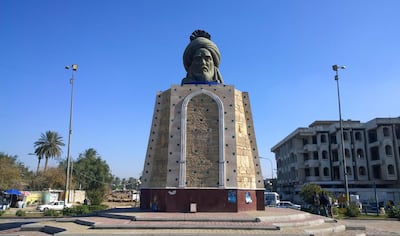Iraqi President Barham Salih dismissed calls by radical Shiites to demolish the shrine of a revered Sunni leader in Baghdad, saying the inflammatory remarks came from “discordant voices”.
Government officials and community leaders scrambled to contain rising sectarian tensions after calls spread on social media to demolish the shrine to Imam Abu Hanifa Al Numan, the founder of the Hanafi school of Sunni jurisprudence .
The calls were believed to have originated with the Al Shirazi group, which has followers in Iraq, the Gulf states and Britain and is known for opposing prominent Sunni imams and even other Shiite groups.
"These discordant voices do not represent the reality in this society," Mr Salih told a gathering of Sunni clerics and Sunni Endowment officials in Abu Hanifa mosque, which is built over the shrine to the imam.
The group is also believed to be behind calls to demolish a statue of Abu Jaafar Al Mansur, an Abbasid Caliph who founded Baghdad in the 8th century.
They accuse both of them of killing Imam Jaafar Al Sadiq, the sixth of 12 imams revered by Shiites.
The calls were shared widely on social media in Iraq, accompanied by an audio recording attributed to the group’s spiritual leader, Grand Ayatollah Sayyed Sadiq Al Husseini Al Shirazi, in which he blamed Iraq’s problems on the shrine.
“I say, If Iraqis want to get rid of their problems, they have to demolish the tomb of Abu Hanifa and turn it into a park,” he said.
“After that, you will see, all Iraq’s problems will be solved automatically. Iraq will not see any good with the presence of Abu Hanifa's tomb.”
To prevent protests or any further escalation, Iraqi security forces were sent to the mosque over the weekend but no protesters showed up.
A handful of demonstrators did gather around the statue of Al Mansur, but they were dispersed by the security forces.
In an effort to draw attention to the history of centuries of peaceful coexistence between Sunnis and Shiites in Baghdad, Mr Salih earlier visited the shrine of Moussa Al Kadhim – a Shiite imam who died at the end of the 8th century – in the Shiite majority Kadhimiya district, before crossing the bridge to Adhamiya, the Sunni majority neighbourhood where the Abu Hanifa mosque is located.
“I want to send a message to underline the values, history, ethics and the religion that we share, that resists sedition and anyone who wants to target our unity and harmony,” he said.
Since last week, Shiite religious leaders and their supporters have descended on Abu Hanifa mosque to express solidarity. Some of them held joint prayers in a gesture of unity.
"The people are aware now and that the scenario of 2006 will not be repeated again," Adhamiya resident Yassir Ismaiel Nassir told The National, referring to the bombing of a Shiite shrine that unleashed a bloody sectarian conflict.
“Seeing senior government officials and Shiites and their religious leaders here today among us is a source of comfort to the residents of Adhamiya,” Mr Nassir said.
“The years of sectarian fighting are gone,” he said.



